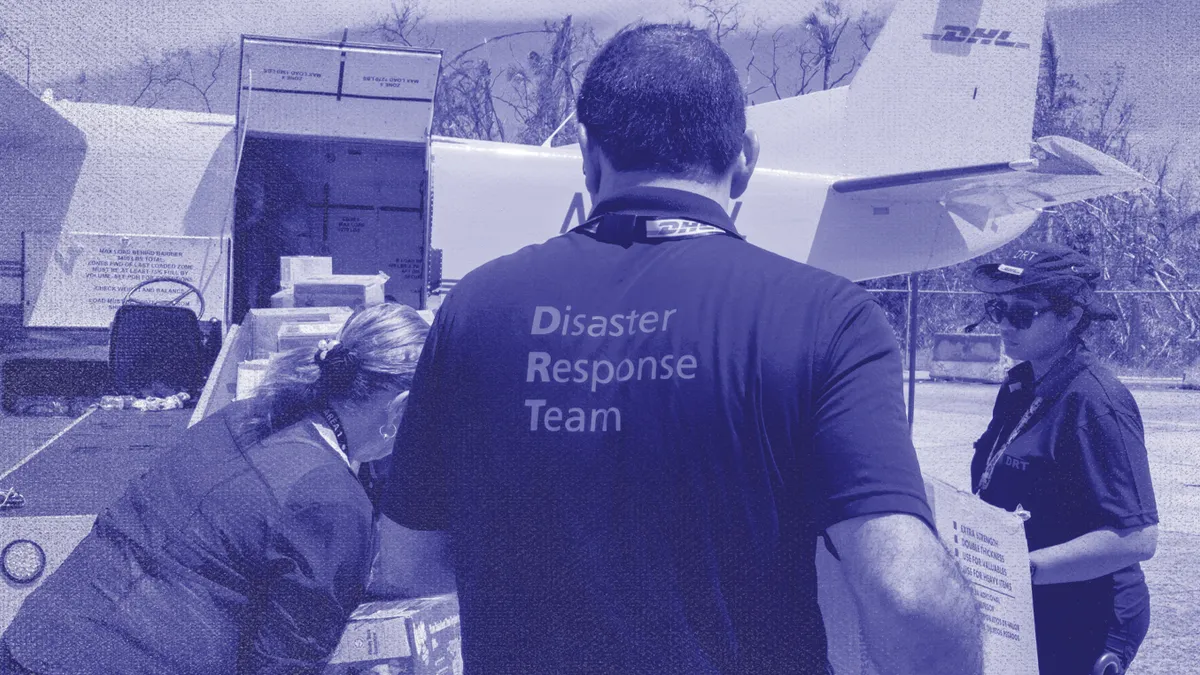This article is part of a series on natural disaster preparation and response. View all the articles here.
Walking through parts of San Juan, Puerto Rico today, the effect of Hurricane Maria is largely invisible. But every so often, turn a corner and there she is in a mostly vacant building or a severely damaged school stadium.
After the storm made landfall, parts of Puerto Rico lost power for 11 months. Cell phone service was down for months too — in fact, Maria was the only hurricane of the last five major U.S. storms to wipe out 100% of cell towers in the affected area for at least 10 days, according to The Wall Street Journal.
Ewar Rivera knows a thing or two about hurricanes. He’s DHL’s director of operations for supply chain services in Puerto Rico and was tasked with getting his operation and his customers through the historic 2017 storm. Though no one could anticipate what kind of damage the island’s first Category 5 hurricane since 1928 would bring, DHL was as prepared as it knew how.
After Maria, DHL was able to get its 10 warehouses on the island up and running within 36 hours.
The rarity of such a powerful storm on the island is proof, according to a new report from DHL, that all supply chains and all facilities need robust continuity plans that account for extreme disasters, no matter past frequency.
"Most areas of the plan had contingencies based on previous experience with hurricanes in the zone, however, one of the elements that is very hard to prepare for and tackle, is the total loss of communication," Rivera told Supply Chain Dive. Luckily, DHL's contingency accounted for a communications blackout even though it was unlikely.
According to DHL’s Resilience 360 platform, the Americas can expect four major hurricanes this season. As hurricane season arrives, DHL is preparing to do this all again — hopefully not at the scale of Maria. Here are DHL's crucial elements to a controlled response to uncontrollable disasters, as explained by Rivera.
1. Get inventory in place before landfall
According to Rivera, 90% of goods coming into Puerto Rico arrive by ship. DHL’s customers needed to be ready for no ships to arrive for an unpredictable amount of time, so they stockpiled. Beyond survival staples like water, goods such as diapers, non-perishable food and cleaning products are much-needed after a storm. Rivera and his team worked with clients to get these items in stock well before Maria arrived. DHL also had a standing agreement with fuel, water and internet suppliers well in advance so it could understand what to expect and get crucial operational supplies without additional communication.
2. Put standing orders in place
When stockouts are almost assured and communication is an open question, Rivera recommends getting post-storm orders on the books before the trouble starts. This way, as soon as supply is available, the product can ship without the need for any communication.
3. Make a communications plan
Rivera said although some communications interruptions were expected during Maria, the extent of the blackout was not. When it comes to communicating with clients and employees, DHL had layers of backups in place including satellite phones and an AM radio station employees were to listen to for announcements in the worst case scenario, which Maria turned out to be.
4. Reserve reliable workspace
What made all the difference for DHL employees and clients in the days following the storm was a handful of hotel rooms. Before the storm, the carrier booked rooms at hotels with robust infrastructure that were likely to maintain (or quickly regain) power, phone service and internet. Clients were welcome to work from these rooms, and DHL kept the rooms and its warehouses supplied with food for workers and clients.
5. Account for aid
In almost any natural disaster, after the event has subsided, an influx of aid arrives in the form of water, food, healthcare supplies, clothes and more. Supply chain players can offer crucial support in receiving and moving these goods (just ask American Logistics Aid Network). DHL organizes employee volunteers dedicated to working with aid organizations and managing incoming supplies. In the case of Maria, six DHL employee volunteers from Latin America, Germany and the U.S. formed a disaster response team to keep aid moving around the island using DHL vehicles and aircraft.
6. Don’t discount security
Beyond physical goods in storage, DHL also controls sensitive client information digitally and on paper. Securing all of this was paramount before, during and after the storm using security personnel. The team also needed to make sure it had couriers on call because document transfer has to go old school when electronics go down.
The Series
-
How P&G created a 'ready for anything' supply chain
For the last decade, the CPG giant has been on a mission to use technology to take the guesswork out of disaster response.
-
In disaster response, health supply chain egos melt away
A speedy post-hurricane return to normal requires competitors to become collaborators to effectively manage inventory and cold chains.
-
Florida manufacturing at risk this hurricane season
Storm outages and disruptions to the Port of Miami and Miami International Airport "may cause ripple effects" through global supply chains, according to a DHL Resilience360 report.






















